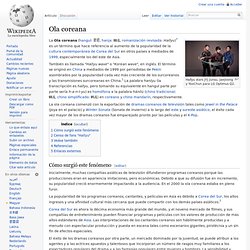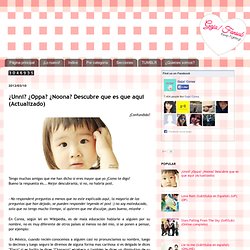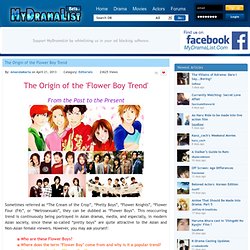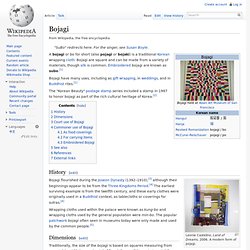

Ola coreana. Hallyu stars JYJ Junsu, JaeJoong y YooChun para LG Optimus Q2.

La Ola coreana (hangul: 한류, hanja: 韓流, romanización revisada: Hallyu)? Es un término que hace referencia al aumento de la popularidad de la cultura contemporánea de Corea del Sur en otros países a mediados de 1999, especialmente los del este de Asia. También es llamada "Hallyu wave" o "Korean wave", en inglés. El término se originó en China a mediados de 1999 por periodistas de Pekín asombrados por la popularidad cada vez más creciente de los surcoreanos y las transmisiones surcoreanas en China.[1] La palabra hanlyu (la transcripción es hallyu, pero tomando su equivalente en hangul parte por parte sería h-a-n-l-yu) es homófona a la palabra hánliú (chino tradicional: 韓流, chino simplificado: 韩流) en coreano y chino mandarín, respectivamente. Cómo surgió este fenómeno[editar] ¿Unni? ¿Oppa? ¿Noona? Descubre que es que aqui (Actualizado) ~ OLACOREA!
Tengo muchas amigas que me han dicho si eres mayor que yo ¿Como te digo?

Foros - Can you name all the Korean words you learned from watching Kdramas/Kmovies? - Página 7. Untitled. The cultural issue of "respecting someone because they are older than you" came up during conversations last night.

The husband and I were trying to explain this Korean cultural phenomenon to our guest, who was white. My husband is a 2nd generation Korean and grew up in mostly white neighborhoods until college. I, on the other hand, am closer to 1.5 generation and had many Korean friends. We both attended a church during college where it was very normal and sort-of expected that you call older persons Oppa, Unni, Hyung, and Noona. They are terms of respect and endearment. Anyway, this was very strange for my husband and it took him a long time to finally call people hyung or noona. The strange thing is, I don't call my older sister unni.
I also have a friend who is like 2 years older than me and I ALWAYS call her unni. Anyway, the whole "respect for elders" and the "older person looking out for the younger person" aspect of the Korean culture is something that I really love. The Origin of the Flower Boy Trend. The Origin of the 'Flower Boy Trend' From the Past to the Present Sometimes referred as “The Cream of the Crop”, “Pretty Boys”, “Flower Knights”, “Flower Four (F4)”, or “Metrosexuals”, they can be dubbed as “Flower Boys”.

This reoccurring trend is continuously being portrayed in Asian dramas, media, and especially, in modern Asian society, since these so-called “pretty boys” are quite attractive to the Asian and Non-Asian female viewers. However, you may ask yourself: ◘ Who are these Flower Boys? Who are these "Flower Boys"? The term “Flower Boys” has several meanings depending on how it is used. Basically, these are guys who do not fit within the typical look of masculine, tough-looking men. How do you classify a "Flower Boy"? Flower Boys can be classified looking at the different terms in the chart: Where does the term "Flower Boy" come from and why is it a popular trend?
Bojagi. "SuBo" redirects here.

For the singer, see Susan Boyle. A bojagi or bo for short (also pojagi or bojaki) is a traditional Korean wrapping cloth. Bojagi are square and can be made from a variety of materials, though silk is common. Embroidered bojagi are known as subo.[1] Bojagi have many uses, including as gift wrapping, in weddings, and in Buddhist rites.[1] The "Korean Beauty" postage stamp series included a stamp in 1997 to honor bojagi as part of the rich cultural heritage of Korea.[2] History[edit] Leonie Castelino, Land of Dreams, 2006.
Bojagi flourished during the Joseon Dynasty (1392–1910),[3] although their beginnings appear to be from the Three Kingdoms Period.[4] The earliest surviving example is from the twelfth century, and these early clothes were originally used in a Buddhist context, as tablecloths or coverings for sutras.[4] Wrapping cloths used within the palace were known as kung-bo and wrapping cloths used by the general population were min-bo. Dimensions[edit] Glosario: Términos comunes. Quizás no sabemos la escritura y/o pronunciación correcta, pero todos hemos escuchado algunas palabras ya muchas veces, que estamos familiarizados con ellas y entendemos su significado, tanto así, que la empleamos en nuestra vida diaria, cambiando un “GRACIAS” por un “KOMAWO“, o un “MAMÁ” por un “OMMA“… quizás con un COREAÑOL muy avanzado, que en ocasiones sorprende, aunque claro, a veces, la idea que tenemos no siempre va por buen camino y siempre terminamos preguntándonos ¿Qué significa?.

En este post, intento definir algunas de las palabras coreanas más comunes que se utilizan, en este caso, que podemos escuchar en los dramas. ¿Listos para ver qué tan avanzado es nuestro coreañol? Empezamos con las más comunes y las más usuales, tanto allá como aquí, en el otro lado del charco, y estas son con las que nos referimos a otras personas. OPPA: “Hermano mayor“, utilizado por las chicas, para referirse a un chico mayor que ella. YEO-DONGSAENG: Hermana menorNAM-DONGSAENG: Hermano menor.